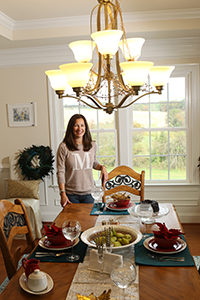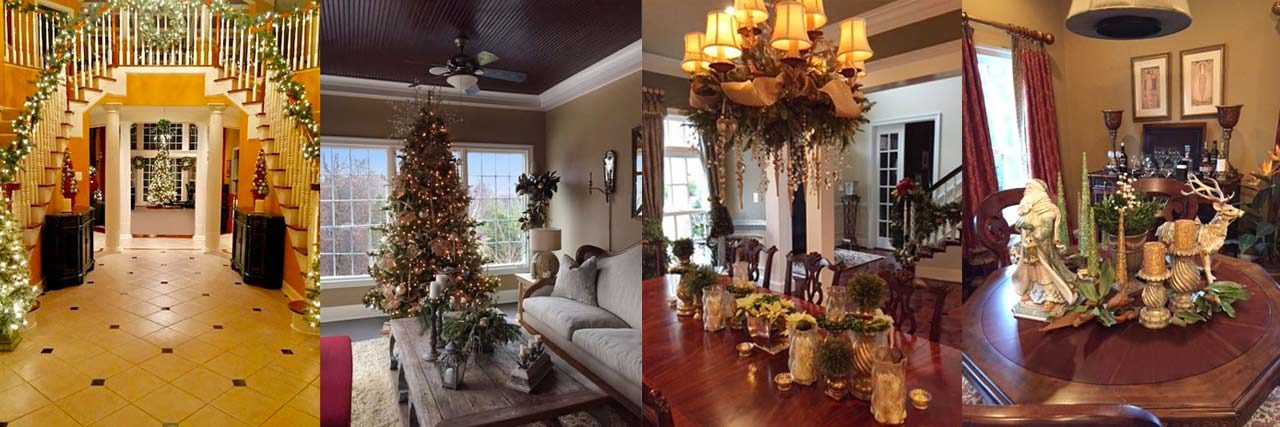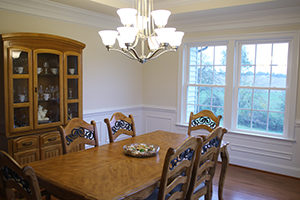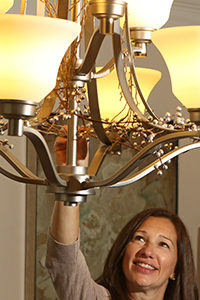by Silvia Blair
The holiday season typically brings out the best in entertaining and decorating, as a time for making a home or apartment look beautiful and inviting for the family, friends and guests who will celebrate with one another.
Transforming a home or apartment into a holiday space can take some ingenuity and imagination. And with the right selections, a home or apartment can become a centerpiece for festivities that looks professionally put together without breaking the bank. All it takes are some simple techniques borrowed from the real estate world.
Staging, the practice of creating a visual presentation that accentuates a dwelling’s best features, is a common practice in the process of buying and selling a home. And it lends itself well to preparations for entertaining. That’s because the principles for how to set up a living space are universal in nature and follow the concept of “less is more.”

After – Julie Moreland stages a clients dining room for the holidays using existing decorations and new.
The Principles of Staging
Kippy Day is a home marketing consultant manager for Creig Northrop Team of Long & Foster Real Estate, which has office in Carroll County among other locations in Maryland.
“Staging provides a competitive edge for preparing a home in a most appealing way,” said Day. “When staging, simplicity is important. A clean interior space allows new homeowners to visualize themselves being in the property. Too many items and excess of stuff can make it difficult to visualize the rooms. Staging principles include empty counters, a pop of color and simple, small accessories,” said Day. “When needed, paint is powerful and can transform the interior of a room.”
Julie Moreland, interior designer and professional stager of the Westminster-based company M.interiors, said staging is becoming more common in Carroll County, as homeowners understand the value of presentation by bringing out their vases, flowers, artwork, and books in neutral and attractive ways.
Moreland said that while every staging job is different, there are common techniques she applies to any residence she works in: keeping surfaces clear and holding clutter to a minimum.
How Staging Helps for the Holidays
Bringing out the holiday decorations from the attic or basement can be a chore. But applying staging principles to holiday decorating is like having a blueprint on how to put the best face on a house or apartment, creating an oasis for conversation and interaction.
Staging does not need to be complicated. Moreland suggests easy steps such as placing furniture in a layout that is conducive to entertaining to create a new feel for the holidays, for example.
“Switching out artwork for wreaths can be a simple, low-cost way to freshen up a room and bring a smile to people’s faces. Decorations should create a common feel by using a general color scheme, which is personalized and to an owner’s liking. Metallic decorations like gold and copper are very trendy now,” she said. “Adding music can be soothing during holiday entertaining. And candles in the windows or classic white lights give that illuminated feeling many people desire.”
Stagers like Day and Moreland may often work with a client’s existing decor to spruce it up for the holidays. A standard dining room chair can have some artsy slipcovers. A table can hold decorations that reflect a homeowner’s traditions, like small Christmas trees or sparkling knickknacks. A dinner place-setting can be supported by a metallic runner, decorated water glasses and combinations of white plates with red plates set off by a solid complementary placemat.
“Such an understated look and feel leads the eye to the most important elements of a dining room setting for a dinner party and keeps distractions to a minimum,” said Moreland.
Applying the staging principle of simplicity is important outside of the home or apartment as well, said Moreland. Colors work well if they are balanced and complement the design, layout and scheme of a dwelling. Window treatments that are visible outdoors also deserve special attention.
Year-Round Decorating
Moreland said that neutral decorating elements from the holidays can remain on display year-round with minor adjustments. “You can maintain a simple, light and airy feel, in which one space flows into the other and everything is in its own place,” said Moreland.
Day adds that “Keeping decor beautiful all year around feels good when you wake up to a new and fresh space. Keeping a home decorated with spaces well-defined can last from one holiday into another.”
Cost-Effective Holiday Staging
Staging for the holidays can be cost-effective when combining what is already in the home or apartment with additional extra touches that follow the basic rules of staging.
- Look at everything you have and rearrange, making new combinations. For example, if you have a dining room cabinet, reorganize the objects and highlight colors that reflect your holiday traditions.
- Move decorations from the room they were in last year to a new room.
- Add a festive area rug under a wooden-legged table to add interesting contrast between the table and a wood floor. And a rug can be much less expensive that laying out a whole room of carpeting.
- Trade decorations at the end of the holiday season with family and friends for a fresh new look for next year.
- Put colorful slip covers on chairs for a new look without buying a new dining room set.



